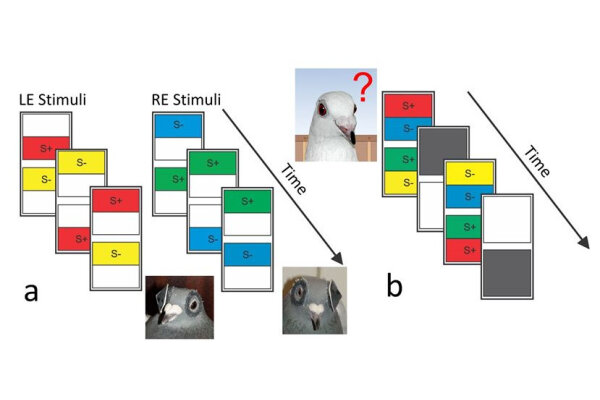2014-05-17

In birds each hemisphere receives visual input from the contralateral eye. Since birds have no corpus callosum, avian brains are often seen as ‘natural split brains’. But if the two hemispheres can’t interact, how do birds cope with situations, when both hemispheres are brought into conflict? Who then is in charge for a decision? If under such conditions one hemisphere completely determines the response, this is called meta-control. The aim of the current study is to test, if meta-control results from an interhemispheric conflict that would require interhemispheric interaction. If such a conflict-based interaction occurs, it should produce a delay in responding. This interaction could happen via the the commissura anterior, a small forebrain commissure that also exists in birds. To this end, biopsychologists from Bochum trained pigeons in a forced-choice color discrimination task under monocular condition such that each hemisphere was trained with a different pair of colors. Subsequently, pigeons were binocularly tested with conflicting and non-conflicting stimulus patterns. Conflicting stimuli indeed produced a delayed reaction time as expected when two divergent decisions create a conflict. Thus, pigeons indeed undergo interhemispheric conflict during meta-control even without a corpus callosum. Their hemispheres then possibly interact via the commissura anterior.

In birds each hemisphere receives visual input from the contralateral eye. Since birds have no corpus callosum, avian brains are often seen as ‘natural split brains’. But if the two hemispheres can’t interact, how do birds cope with situations, when both hemispheres are brought into conflict? Who then is in charge for a decision? If under such conditions one hemisphere completely determines the response, this is called meta-control. The aim of the current study is to test, if meta-control results from an interhemispheric conflict that would require interhemispheric interaction. If such a conflict-based interaction occurs, it should produce a delay in responding. This interaction could happen via the the commissura anterior, a small forebrain commissure that also exists in birds. To this end, biopsychologists from Bochum trained pigeons in a forced-choice color discrimination task under monocular condition such that each hemisphere was trained with a different pair of colors. Subsequently, pigeons were binocularly tested with conflicting and non-conflicting stimulus patterns. Conflicting stimuli indeed produced a delayed reaction time as expected when two divergent decisions create a conflict. Thus, pigeons indeed undergo interhemispheric conflict during meta-control even without a corpus callosum. Their hemispheres then possibly interact via the commissura anterior.